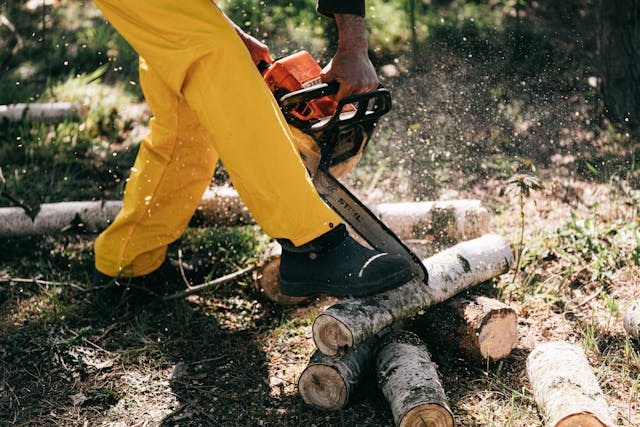Cutting firewood with a battery chainsaw provides convenience and portability, but many users fall into habits that compromise safety and tool performance. While battery-powered models are perfect for light to moderate tasks, it’s necessary to recognize that demanding jobs often require specialized equipment, like heavy-duty electric chainsaws, created for handling thicker logs and tougher wood. Misjudging the tool’s capacity, neglecting maintenance, or skipping safety checks can lead to accidents, tool damage, and inefficient cutting.
This article covers the most common mistakes people make when using battery chainsaws for firewood and provides practical advice to maintain safe, effective operation every time. Whether you’re working with compact battery saws, corded electric chainsaws, or gas-powered models, understanding the right tool for the job is critical. For tasks that need more cutting power, you can find heavy-duty electric chainsaws here that are suited for larger logs and prolonged use. Choosing the right chainsaw not only protects the user but also ensures cleaner cuts, longer tool life, and fewer frustrating setbacks during firewood preparation
Key Takeaways
- Users often make preventable mistakes with battery chainsaws.
- Safe operation and routine checks are crucial.
- Avoiding key errors leads to safer and more efficient cutting.
Critical Mistakes When Using a Battery Chainsaw for Cutting Firewood
Many people make avoidable errors when operating battery chainsaws for firewood, leading to poor performance, safety risks, and shortened tool life. Mistakes with chain tension, overloading, and improper handling are especially common.
Incorrect Saw Chain Tension and Maintenance
A saw chain that is too loose can derail during use, while a chain that is too tight increases friction and wears out prematurely. Regularly checking chain tension before and during cutting sessions is essential. Chains should move freely on the guide bar yet have minimal slack.
Neglecting to sharpen or lubricate the chain leads to slow, rough cuts and puts additional strain on the motor. Dirty or dry chains are also more likely to cause kickback. Proper saw chain maintenance includes routine inspection, cleaning, sharpening, and lubrication.
Overloading the Chainsaw Beyond Its Capacity
Attempting to cut logs that are too thick or dense for a specific battery chainsaw can quickly drain the battery and may overheat the motor. Cutting too quickly or forcing the tool through hard wood increases the chance of stalling or damaging the chainsaw. Users should match tool capacity with the wood’s diameter and type. Always let the saw do the work—apply gradual, consistent pressure rather than forcing the bar through the log. Avoid using a tool designed for pruning or small limbs on dense hardwood or thick rounds. This not only extends battery life but also helps maintain cutting performance.
Improper Guide Bar Handling and Control
Improper hand placement and poor body positioning raise the risk of accidental slips and unsafe kickbacks during cutting firewood. Many incidents happen when users operate the chainsaw one-handed or do not maintain firm, balanced control over the guide bar. Avoid using the tip of the guide bar for cuts, as this area is prone to kickback—one of the most dangerous hazards. Always maintain both hands on the handles and ensure the guide bar is fully supported during every cut.
Positioning matters: keep the saw’s path clear of obstructions, and do not cut above shoulder height or at awkward angles. Secure the firewood properly so it does not shift while cutting. A stable, well-supported cut significantly lowers the chance of losing control and improves cutting accuracy.
Safety and Operational Best Practices to Avoid Common Errors
Safe and efficient firewood cutting with a battery chainsaw depends on using correct equipment, understanding tool limitations, and following established safety measures. Addressing these factors directly reduces risk of injury and increases the effectiveness of every cut.
Failing to Wear Protective Equipment
Operators sometimes underestimate the dangers of a battery chainsaw, thinking it is less hazardous than a gasoline chainsaw. However, the spinning chain and sharp teeth present the same risk of cuts and kickback injuries.
Key items for personal protection include:
- Cut-resistant gloves to shield hands from sharp debris.
- Safety goggles or a face shield to prevent eye injuries from wood chips.
- Hearing protection—even battery models can be loud during extended use.
- Steel-toed boots to protect feet from falling logs or accidental contact with the chain.
- Chainsaw chaps or cut-resistant pants for leg protection.
Neglecting any of these can make a minor slip much more severe. Users should inspect this safety gear frequently to ensure it remains functional.
Using Inappropriate Chainsaw Types for the Task
Selecting the wrong chainsaw for the size and type of firewood can lead to dangerous situations. Battery chainsaws have varying power levels and bar lengths. Using a model with a short guide bar on large, dense logs can overwork the motor, slow down cuts, and force the operator to use unsafe techniques.
A good rule is to match the guide bar length to the diameter of the wood being cut. Heavy-duty tasks may be better suited to specific models with longer bars or more robust batteries. Consulting the manufacturer’s specifications can help prevent stalling and overheating, which are common errors when the chainsaw is underpowered for the job.
Conclusion
Battery chainsaws provide a reliable and efficient way to cut firewood, but users must avoid common mistakes to work safely and effectively. Missteps such as neglecting safety gear, improper tool handling, and poor maintenance are frequent causes of accidents and decreased performance.
Staying alert to safety, checking each step before operating, and using the correct cutting techniques help minimize risks. Proper handling and regular maintenance not only protect the user but also extend the life of the chainsaw. By consistently applying these best practices, users can improve their results and reduce the chance of injury or equipment failure.




